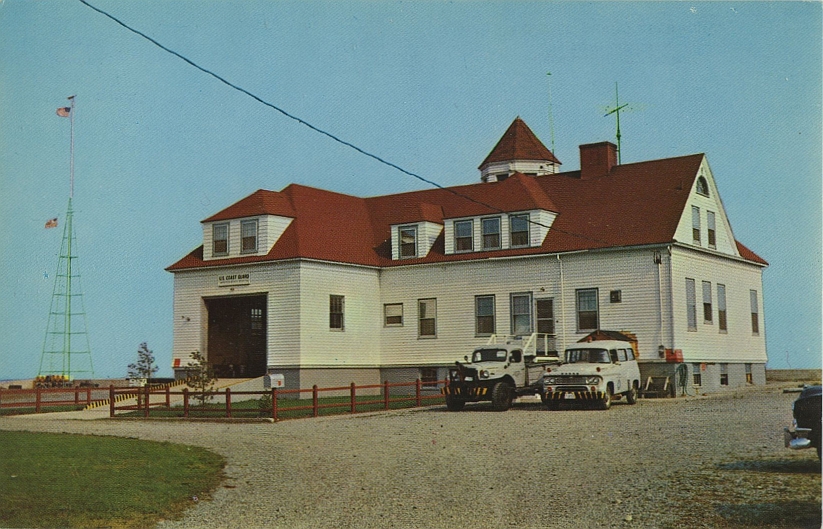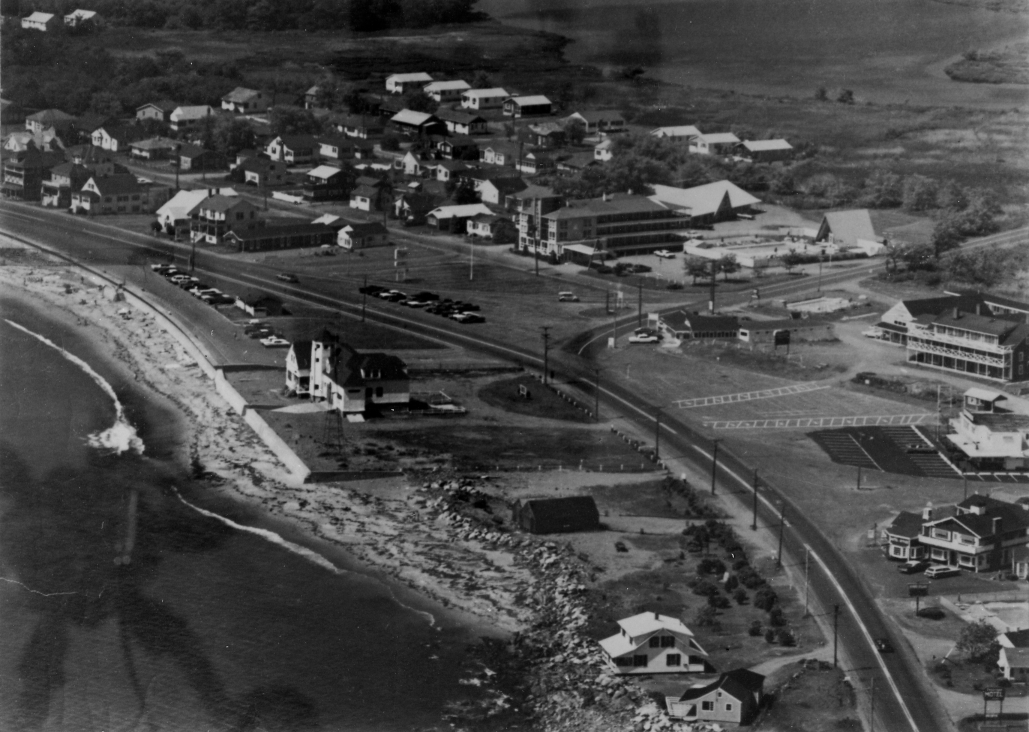By Lynn Harnett
Bordertown News
Wednesday, May 2, 1973station, the Spindrift Motel (the former Taybury Arms), and at right, the former
Leavitt Homestead, (with the former "Barn Theatre" adjoining) now the
Windjammer Motel (1961). At extreme right is the former "Palmer's Clamshell
Restaurant."
[Photo not in original article.]
HAMPTON, N.H. — The fire department has begun conducting experiments at the Hampton Beach Coast Guard Station which is scheduled to be razed to the ground within the next couple of weeks.
Monday and Tuesday of this week the police department used the station for tear gas training for their regular men and special forces, to get the crews used to the gas in the event they should ever have to use it, Fire Chief Paul Long said.
In conjunction with the state fire marshal’s office, the fire department this week is running various tests on arson methods, the study of fires in confined spaces, common causes of house fires, and how long it takes these fires to build up and travel. Methods of extinguishing fires, such as the use of fog, are also being studied.
Experiments directed yesterday, said Chief Long, were concerned mostly with fire accelerants “from the simple candle to sophisticated chemicals.” Studies were made of time-bomb type fires as well as those started by molotov cocktails, gasoline, lacquer, and chemicals to see how long it would take for such a fire to start and how it would travel. Through such methods, the department can discover how much time an arsonist would need to get away from the scene and establish an alibi, Long said.
Experiments will be made on cigarette butts thrown in waste baskets or left on mattresses.
The fire crews next week will be training with confined fires in closets and small spaces. Some old furniture will be used to set up a room.
No tests will be conducted on the weekends, said the chief, because crowds would be attracted. He could not say exactly when the final fire that will raze the building will be as firemen will continue experiments as long as possible.
Mutual Aid Call
Mutual aid from surrounding towns will be used when the station is burned so that equipment and firefighting methods can be compared.
Electrical appliances and faulty or frayed wiring will also be tested. Chief Long cited the example of a lamp cord run under a rug -- how far must it be frayed before it starts a fire?
The main building of the station was constructed in 1898 and the Coast Guard closed the station for the first time in November 1946, “despite the protests of numerous citizens and organizations in the Seacoast area,” said a local newspaper at the time. The paper went on to say that the station’s closing left “the entire length of New Hampshire seacoast without protection.”
The following year the boards were removed from the windows “following vigorous protests by the residents of this area with the aid and assistance of U.S. Rep. Chester E. Merrow and state Sen. Doris Spollett of Hampstead,” the paper reported. A crew of five men were assigned to the reopened station which remained open until July 21, 1967.
In July 1967, the old station was vacated and the station moved to a leased house at Hampton Beach Station, Harbor Road.
Jan. 14, 1970 a news release was issued by the Coast Guard from Boston stating that the beach station would not be reopened, upon the decision of Admiral Willard J. Smith, commandant of the Coast Guard. The news release said an analysis of the work load showed that requests for assistance were received “almost exclusively during the warm months, primarily on weekends and holidays during the daylight hours.
It was decided to use the personnel and equipment normally engaged at the Hampton Beach Station to augment the facilities at the Merrimac River Coast Guard Station, Newburyport, Mass. deploying patrols from the Merrimac River Station to Hampton Beach during “periods of high search and rescue potential, such as weekends and holidays.”

HAMPTON BEACH, NEW HAMPSHIRE
Mcintyre Objects
This action was highly opposed by U.S. Sen. Thomas J. Mcintyre, R-N.H., who said he would “do everything in his power” to reverse the Coast Guard’s decision.
Mcintyre said Hampton Beach was one of the fastest growing areas on the coast and was in need of more protection for small boats and fishermen, not less. He cited the rapid growth of the area as a recreational playground and said “there will undoubtedly be more calls of distress requiring quick response”
However, Mcintyre’s efforts failed, and although the town sought a use for the building over the past few years, all schemes have been deemed too expensive to be carried out.
There are many small rooms, especially on the second story, and to give the building a meeting hall, it could be necessary to rebuild the support structure, said Chief Long.
One plan had been to turn the station into a day school, but the building has only one exit. Therefore, to meeting fire requirements, another exit would have to be put in and a fire alarm system installed.

